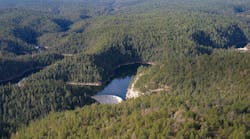Over the last 10 years, Arizonans have watched as large wildfires ravaged the watershed in and around the Salt and Verde Rivers — a critical source of water for central Arizona and the Phoenix metropolitan area. The devastation proves one important fact that must be addressed now: U.S. forests are unhealthy. Unhealthy and overgrown forests on National Forest System (NFS) lands act as fuel for large catastrophic wildfires that affect water and power infrastructure. Large-scale, high-severity wildfires make average precipitation events extremely destructive; accelerating flood flows and toxic runoff, eroding soils, depositing sediment into water storage reservoirs and, ultimately, causing millions of dollars in
infrastructure damage and reduced water storage capacity.
Wildfires also create a direct threat to T&D infrastructure, which can result in widespread power outages. Additionally, fires in the wildland-urban interface, the area where houses and other structures meet undeveloped wildland vegetation, can lead to prolonged poor-air quality, flash flooding and direct economic losses that can threaten the fabric of local communities.
According to a study published in the Nature Sustainability journal in July 2023 — Human and Infrastructure Exposure to Large Wildfires in the United States — primary population exposure to wildfires in the U.S. increased 125% from 2000 to 2019. Salt River Project (SRP) and the communities it serves have seen firsthand the direct and long-term impacts of wildfire.
An Ambitious Goal
SRP is a community-based, not-for-profit organization that provides water and power to more than 2 million people in central Arizona. The utility operates and maintains seven reservoirs, owned by the Bureau of Reclamation, that provide a reliable, affordable and sustainable water supply to the Phoenix metropolitan area. On the power side, SRP provides a diverse portfolio of generation resources across Arizona to meet customer needs. The prevention of catastrophic wildfire is critical to the long-term sustainability and reliability of SRP’s power and water supplies and infrastructure.
Since 2000, the watersheds SRP depends on have experienced seven megafires, which are wildfires that burn in excess of 100,000 acres (40,469 hectares). These megafires burned more than 3.5 million acres (1.4 million hectares).
In 2019, SRP’s Board and Council recognized the urgency of wildfire risk across the watersheds and the need to dramatically increase the pace and scale of forest restoration by establishing a forest health goal of helping to thin 800,000 acres (323,749 hectares) by 2035 — an ambitious goal that shows SRP’s dedication to stewardship of the watersheds and valley communities. The utility’s commitment is an investment, but in a cost-benefit analysis conducted by the Electric Power Research Institute, it was concluded the cost of wildfire and post-wildfire impacts is 10 times higher than the cost of preventive forest restoration work to reduce catastrophic wildfire risk.
Securing Funding
SRP cannot achieve its forest health goal alone. The utility has been working diligently to bring together nonprofit, private, federal, state and local partners to collaboratively fund and implement landscape-scale forest thinning projects. Since about 60% of the land in SRP’s watersheds is managed by the U.S. Forest Service, partnership with the agency and their collaboration on projects via a Good Neighbor Authority agreement with the Arizona Department of Forestry and Fire Management has been a crucial foundation in increasing the pace and scale of restoration.
Through SRP’s experience in helping to fund more than 31,000 acres (12,545 hectares) of restoration to date and its commitments to fund an additional 62,000 acres (25,091 hectares) over the next 10 years, the utility has learned one of the largest barriers to landscape-scale forest restoration implementation and wildfire risk reduction is securing long-term and consistent funding sources. Most forest restoration projects SRP engages in require additional funding outside of the utility’s investments to accomplish the desired project outcomes. SRP has built a strong foundation of long-term partners through memorandums of understanding that provide consistent funding for projects with benefits that align to mutual interests and goals.
Corporate Investments
One way SRP has proven successful in financing restoration projects is through modeling and quantifying the water and carbon co-benefits of forest thinning projects — particularly by packaging these quantified benefits together to attract corporate investments. For example, SRP’s water benefit modeling efforts have shown that the removal of forest cover and vegetation density increases water yields by decreasing evapotranspiration, leading to more resilient ecosystems and improving watershed health. Additional modeling has shown these restoration treatments help to avoid carbon dioxide emissions from wildfires and protect the carbon stored in existing trees.
In the last year, several corporations, including PepsiCo Inc., Google LLC and EdgeCore, have announced investments in SRP’s restoration projects, totaling more than US$1.2 million, in exchange for receiving co-benefits that can help them to achieve their own corporate sustainability goals.
Building on this success, SRP was awarded $500,000 in 2023 through the U.S. Endowment for Forestry and Communities’ Innovative Finance for National Forests grant program. This grant will help to facilitate three main goals and outcomes:
- SRP will streamline its existing water benefit model into a scalable, efficient web-based platform to quantify the water supply impacts of forest restoration treatments.
- The utility will package the water and carbon model results with additional project co-benefits to expand and diversify the composition of funding from long-term partners and private investors, through the development of a comprehensive project portfolio. The pairing of quantified water and carbon benefits into one watershed project has proven to attract private contributions with a public-private partnership model.
- Lastly, recognizing that forest restoration implementation is vast and urgent and affects many western states, SRP will engage in national networks and platforms to share its innovative finance strategies to inspire other utilities to scale their efforts and investments in forest restoration projects across the U.S.
Collective Efforts
In 2025, SRP looks forward to sharing its innovative funding strategies with other electric and water utilities, so together the industry can accomplish nationwide reductions in wildfire risk, protect critical infrastructure, and ensure resilient power and water supplies for future generations. Although SRP is a regional organization, the work it has done so far has paved the way for other utilities across the nation to invest, advance and expand this paramount work beyond Arizona.
A financial model that blends funding streams, is backed by a public utility and uses additional implementation partners can be replicated across the U.S to address forest restoration challenges. SRP encourages other utilities to recognize the pressing need to join and amplify the collective efforts to achieve landscape-scale restoration needs.
Elvy Barton ([email protected]) is senior manager of the water and forest sustainability group at the Salt River Project (SRP). Her team leads SRP’s efforts on water conservation and forest health. In addition to working at SRP, Barton is an Academic Associate for Arizona State University’s school of sustainability. Prior to working at SRP, Barton was a senior policy advisor at the Arizona legislature, working on natural resource and water policy. Barton has a bachelor’s degree in political
science, a master’s degree in public administration and an executive master’s degree in sustainability leadership from Arizona State University.







